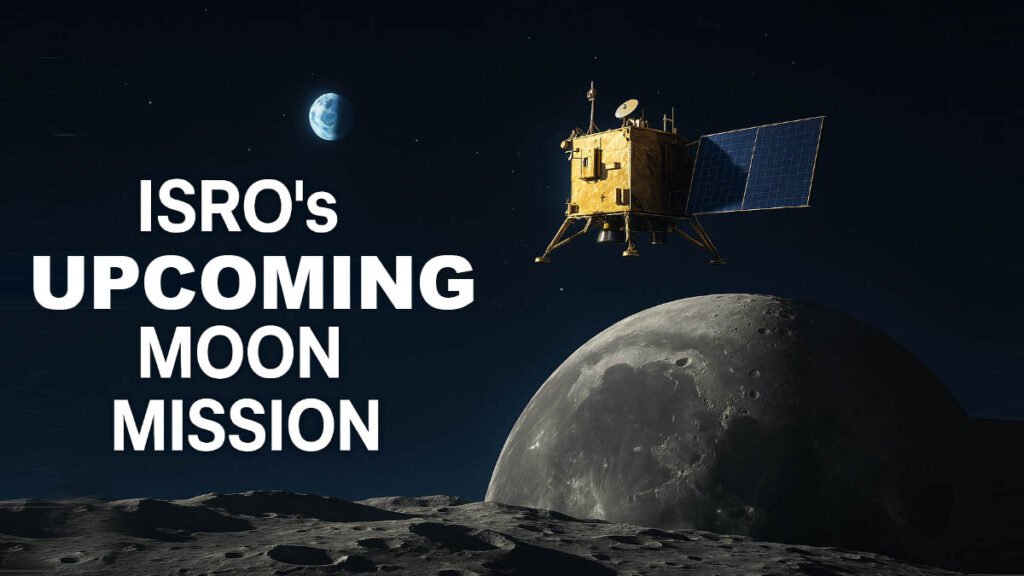Big Highlights of ISRO Upcoming Moon Mission You Should Know in 2025
India’s space program is on a roll. After the global success of Chandrayaan-3, all eyes are now on ISRO upcoming Moon mission, expected to be one of the most ambitious yet.
The mission may still be a year or two away, but details are already making waves in the global space community. Will it involve a Moon rover? A sample return? Or even prepare the ground for India’s first crewed mission to space? Let’s break down what we know — in simple, easy-to-follow language.
🚀 What Is ISRO Upcoming Moon Mission?
The ISRO upcoming Moon mission is probably going to be a sample return mission, which means India intends to send real lunar rocks and dirt back to Earth, according to scientists and internal documents that have been released.
After China, the United States, and the Soviet Union, India would be the fourth nation to achieve this feat if it is successful. Though the mission hasn’t been officially named, many are referring to it as Chandrayaan-4, following the legacy of Chandrayaan-3.
🔍 What to Expect from the Next Lunar Mission
Here are the major features and upgrades expected in ISRO upcoming Moon mission:
1. Lunar Sample Return Technology
This is going to be a big technological breakthrough. Among the mission’s objectives are landing on the moon, collecting samples, and safely returning them to Earth. For that, accurate engineering, a reliable return module, and robust re-entry systems are required.
2. Joint ISRO-JAXA Partnership
Japan’s space agency (JAXA) and ISRO will collaborate on this project. India is expected to oversee the lander module, while Japan will provide the launch vehicle and rover. This international collaboration enhances the mission’s chances of success by combining technological strengths.
3. Launch Date: Late 2025 or early 2026
ISRO scientists have alluded to a launch date of late 2025 to early 2026, but no formal date has been announced. Final testing, integration, and international preparedness will all be important factors.
4. Area of Focus: Moon’s South Pole
As the Moon’s south pole is believed to have frozen water in its permanently shadowed craters, the ISRO upcoming Moon mission is expected to continue its investigation. The information gathered here could be useful for future manned missions or lunar settlements.
5. Better Lander Systems
By incorporating better navigation, increased impact protection, and autonomous decision-making AI to improve landing precision, the new lander will expand on the accomplishments of Chandrayaan-3. A sample return task requires these characteristics.
🌍 Why Does This Mission Matter?
This mission could provide India with direct access to moon materials for the first time. By studying these rocks and soil, we can address the genesis, geology, and potential future human life on the Moon.
Further, the ISRO upcoming Moon mission is a component of a larger plan that also involves the crewed Gaganyaan mission and, ultimately, deeper space exploration. India is becoming a leader in space technology, not just catching up.
👥 Final Thoughts
The ISRO upcoming Moon mission is more than just a scientific expedition; it’s a sign that India is aiming high, coming up with innovative concepts, and working with other countries to push the boundaries of space exploration.
This project, which combines cutting-edge technologies and international collaboration, is turning out to be one of ISRO’s most ambitious undertakings to date. Whether you’re an Indian nationalist or a space enthusiast, you won’t want to miss this launch.
You May Read: Catch the Lunar Eclipse 2025: A Once-in-a-Lifetime Blood Moon Viewing Experience
FAQs
What is ISRO upcoming Moon mission called?
It hasn’t been officially named, but many expect it to be called Chandrayaan-4, continuing the legacy of India’s lunar exploration.
Is this a sample return mission?
Yes, one of the core goals of ISRO upcoming Moon mission is to bring lunar rocks and soil back to Earth — a major step in scientific exploration.
Which countries are involved in this mission?
India is teaming up with Japan (JAXA). Japan will contribute with technology and launch support, and ISRO will lead the mission.
When will the mission launch?
The expected launch timeline is between late 2025 and early 2026, though this could shift depending on technical readiness.
How does this help with future human space travel?
In the upcoming decades, ISRO will be ready for increasingly challenging missions, including as crewed Moon missions and perhaps Mars exploration, thanks to this mission.
